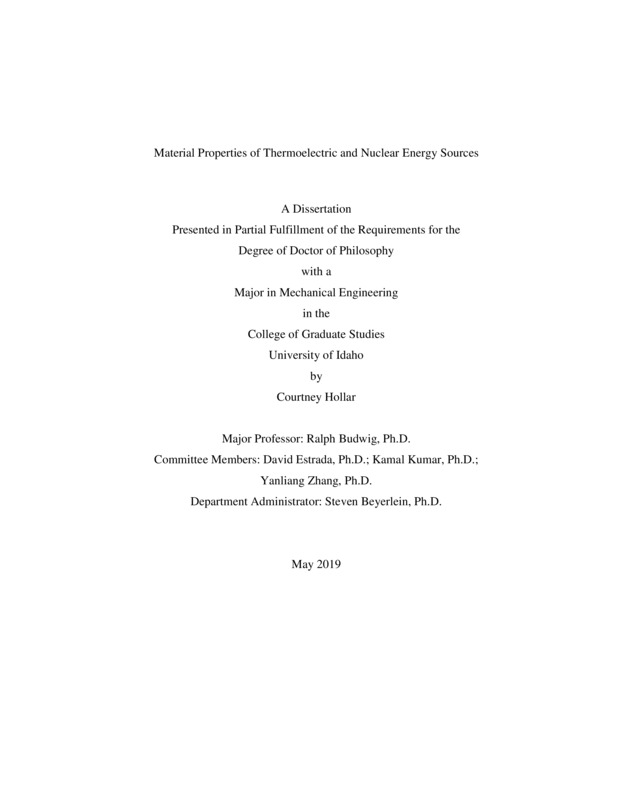Material Properties of Thermoelectric and Nuclear Energy Sources
Hollar, Courtney. (2019-05). Material Properties of Thermoelectric and Nuclear Energy Sources. Theses and Dissertations Collection, University of Idaho Library Digital Collections. https://www.lib.uidaho.edu/digital/etd/items/hollar_idaho_0089e_11540.html
- Title:
- Material Properties of Thermoelectric and Nuclear Energy Sources
- Author:
- Hollar, Courtney
- ORCID:
- 0000-0001-7527-9681
- Date:
- 2019-05
- Program:
- Mechanical Engineering
- Subject Category:
- Mechanical engineering; Alternative energy; Engineering
- Abstract:
-
Thermoelectric generators are a reliable solid-state energy conversion technology. Furthermore, flexible thermoelectric generators are especially of interest due to their potential to power flexible electronics and sensors using body heat or other ambient heat sources. This research focuses on developing flexible, bismuth telluride thin films utilizing a low-cost and scalable wet chemistry method. An overview of current alternative small energy sources demonstrates the need for flexible thermoelectric generators. Thin films fabricated from bismuth telluride nanocrystals exhibited a peak power factor of 0.35 mW/m∙K2 at 433 K, which is among the highest reported values for flexible thermoelectric films. In addition, the change in electrical resistance was 23% after 1000 bending cycles.
Nuclear energy is a large scale energy alternative to fossil fuels which generate minimal environmental emissions. However, the thermal conductivity of nuclear fuel is necessary due to its impact on fuel temperature, the resulting reactor performance, and safety considerations. This research works to overcome this problem by utilizing an in-pile thermal conductivity measurement in order to determine the thermal conductivity under prototypic conditions over a range of burnup. A multilayer quadrupoles analytic model is developed to describe the transient thermal interactions between a line heat source and nuclear fuel for in-pile thermal conductivity measurements. The analytic model was verified using a finite element analysis. Ultimately, the analytic model was used to perform parameter and sensitivity studies to explore the viability of accurately measuring the sample thermal conductivity under various measurement conditions. The analytic model was then compared to experimental measurements of polytetrafluoroethylene and stainless steel 304, which showed good agreement. Using the analytic model, optimization of the needle probe was then performed in order to improve the accuracy of thermal conductivity measurements for UO2 related to the fuel diameters, various probe diameters, and thermal contact resistance. The standard equation for data reduction using the slope to determine the thermal conductivity is not capable of measuring samples with prototypic diameters. However, the validated analytic model provides the foundation to elucidate a better understanding of in-pile thermal conductivity measurements in samples with a diameter as low as 10 mm.
- Description:
- doctoral, Ph.D., Mechanical Engineering -- University of Idaho - College of Graduate Studies, 2019-05
- Major Professor:
- Budwig, Ralph
- Committee:
- Estrada, David; Kumar, Kamal; Zhang, Yanliang
- Defense Date:
- 2019-05
- Identifier:
- Hollar_idaho_0089E_11540
- Type:
- Text
- Format Original:
- Format:
- application/pdf
- Rights:
- In Copyright - Educational Use Permitted. For more information, please contact University of Idaho Library Special Collections and Archives Department at libspec@uidaho.edu.
- Standardized Rights:
- http://rightsstatements.org/vocab/InC-EDU/1.0/

